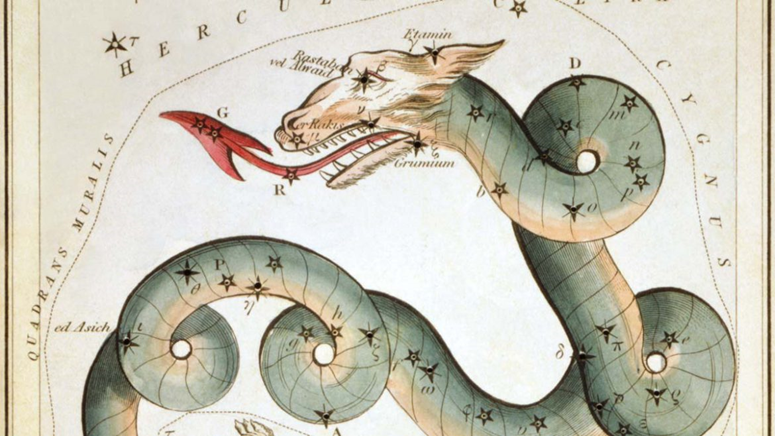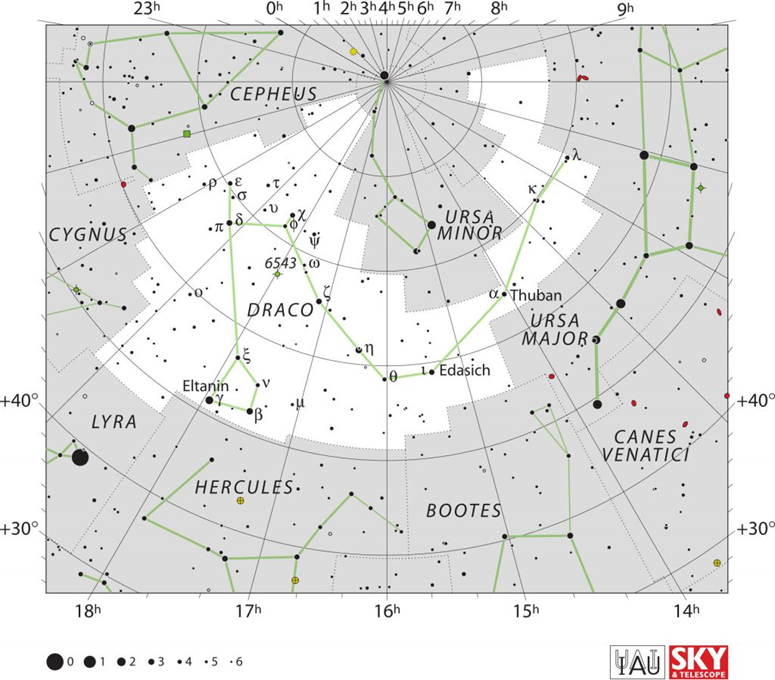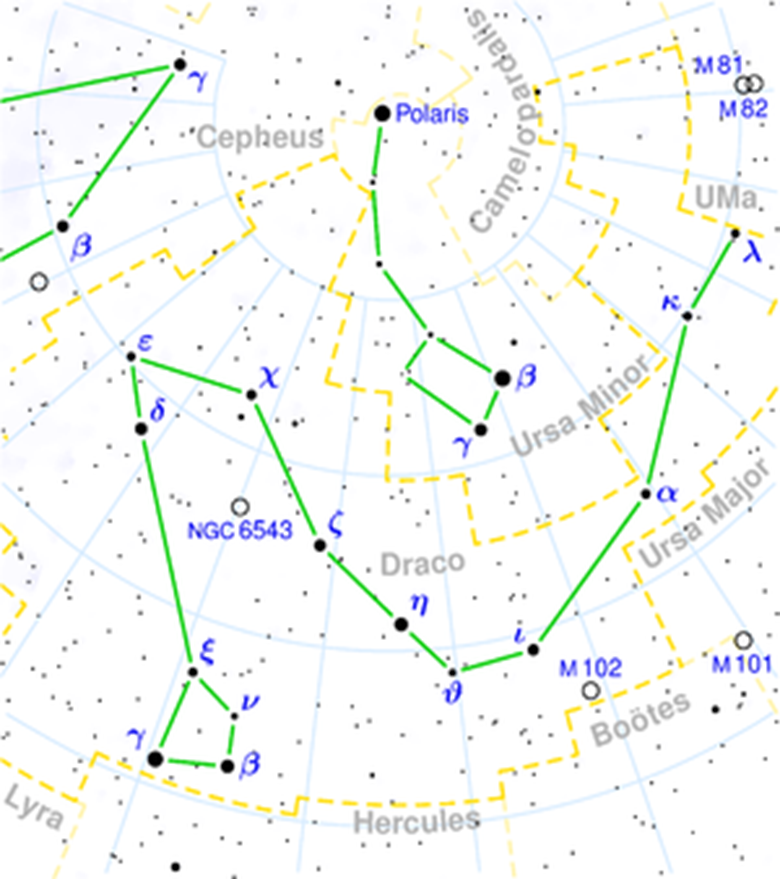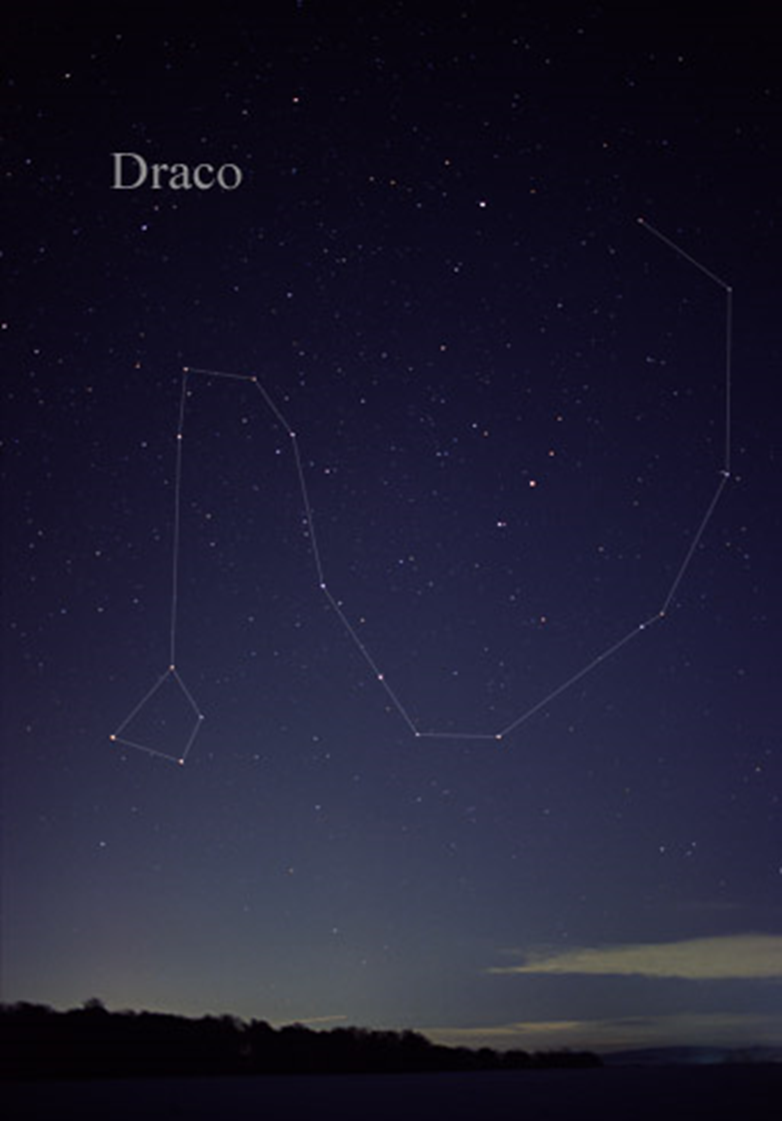dragon (constellation)

Dragon (Latin: Draco); (English: The Dragon). It is one of the signs of the northern hemisphere.
The Serpent Star (Alpha Draco) of the Draco constellation was the North Star 4,000 years ago. But because the Earth's axis changed from what it was before, the star Capricorn (Alpha Ursa Minor) became the current North Star. It is also expected that the current North Star (Capricorn) will change within 10,000 years or more, so that the star Vulture, located within the constellation Lyra, will become the new Pole Star.
The Dragon Tower contains details of several galaxies, nebulae, and star clusters. The most important examples of Dragon Tower galaxies are: NGC 5866, NGC 4125, NGC 4236, and UGC 10822.
The most important nebulae: the Cat’s Eye Nebula NGC 6543,
the most important star clusters: the triple Dra 16, Dra 17, Dra 39.
Examples of Dragon Tower stars include: The Serpent ( Alpha Dragon), Snakehead (Beta Dragon), Dragon (Gamma Dragon), Delta Dragon, Epsilon Dragon, Zeta Dragon, and Iota Dragon.
Describe it

The constellation Draco is an extended constellation in the sky near the constellation Ursa Minor. Four stars that are clear to the naked eye form the dragon’s head - and according to ancient legend, they are directed to the Gathean or “Hercules”, and the dragon looks at him with two colored eyes: the star is the head of the serpent, which is green, and the dragon (Gamma Draconis), which is red.
At the center of the dragon is a beautiful nebula called the Cat's Eye Nebula, NGC 6543
the date
The constellation Draco belongs to the forty-eight ancient celestial constellations, and was mentioned by the astronomer Ptolemy in his Alexandrian manuscripts. According to ancient Greek astronomers, the Little Dipper belonged to the constellation Draco, given that the Little Dipper forms a wing of the dragon.
Due to the precession of the Earth's axis, the Serpent Star (Alpha Dracon) was in the place of the Pole Star in the Northern Hemisphere 5,000 years ago. The minimum distance between the North Celestial Pole and the Serpent star was about 10 arc minutes before 2830 BC.
His celestial bodies
There are many Arabic origins for the dragon stars in European languages, such as the dragon Ettanin, the serpent Thuban, the head of the serpent Rastaben, and others.
The star, Ettanin the Dragon, is the brightest star and is 150 light-years away from us. It has a spectral classification of K5 III.
The binary star system ν Draconis is about 120 light-years away from us, and the two stars that make up this system can be easily seen with close-up glasses, as the angle between them is equal to 62 arcseconds.

The Dragon-39 system is a system consisting of three stars rotating around its center of gravity, and the system is about 150 light-years away from us.
R and T Draconis are two star-type variable stars, both of which are red giants. Both stars expand and then contract again periodically, and this appears to be a clear change in brightness. Stars R and T can be observed during their maximum brightness and their brightness can be seen changing. At the lower end of brightness the luminosity drops below 13m and they cannot be seen with large telescopes.
The Cat's Eye Nebula is a planetary nebula, meaning it is a star in the last stage of its life as it has already expelled its outer gaseous envelope. A very dense white dwarf star remained in the center. The Cat's Eye Nebula NGC 6543 appears in the telescope as a rarefied cloud with a weak star in its center. Astronomers arrived at the well-known image of the Cat's Eye Nebula by observing and photographing it for a long period. The Hubble Space Telescope was also able to capture very beautiful pictures of it.

As for the galaxy, Messier 102, it is an S0 spiral galaxy and is about 30 million light-years away from us.
The galaxy NGC 5907 is a spiral galaxy, Sc, and is about 39 million light-years away from us.
Galaxy NGC 6503 is also a spiral galaxy, Sc, and is about 15 light-years away from us.
These three galaxies are not clearly visible in telescopes and appear as clouds. However, monitoring and photographing for a long period ensures that they are photographed clearly and their features are identified.
Source : websites

